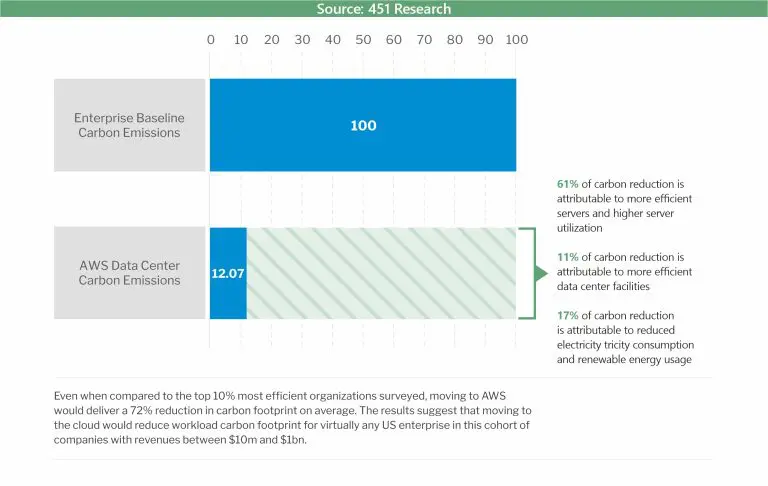Empowering Your Supply Chain: The Transformative Impact of Supply Chain...
Read MoreEnvironmental, Social, Governance (ESG) goals are a measure of every organisation’s sustainability and resilience. The criteria are increasingly used to inform your business’ strategic goals, operational execution, as well as the reporting of sustainable business practices to key stakeholders/customers and potential future investors. This includes the tech sector, who are making significant progress in helping other sectors become more energy efficient. GCP recently commissioned IDG to conduct a study of 2,000 senior IT leaders which resulted in 90% of the respondents agreeing that sustainability is a priority for their IT departments.
The ICT sector is contributing toward cutting down Co2 emissions, improving efficiencies, and making devices smarter and more connected.
Few people understand that computing’s carbon emissions account for 1.4% of the global greenhouse gas (GHG) footprint, or that this will rise to 14% by 2040. Data centres make up the largest share of this percentage and are noticeably bad for the environment. Organisations can considerably reduce their carbon footprint if they opt for cloud computing as opposed to buying and physically maintaining a physical infrastructure. Cloud providers host thousands of businesses with different usage patterns. They can therefore predict the usage more accurately by using fewer servers and less energy to achieve the same amount of work.
If you are currently wondering how you can upgrade your integration processes to technologies that focus on sustainability, then you may want to consider a different platform for your systems. The benefits far outweigh those you will attain by simply moving to new hardware in order to bring your system up to date. It may be time for a complete technology shift. To help you learn more, this article introduces some of the main vendors in the cloud space and how containerisation technologies can help you move your solutions to the cloud without locking yourself into one vendor.
Popular cloud space sustainability solutions that are tackling environmental impacts:
This SaaS solution connects to multiple data sources in real-time to calculate carbon emissions and provides intelligent insights for carbon reduction. Emissions data can be viewed in a comprehensive report and categorized by the source for targeted emission reduction strategies. Organisations who adopt this infrastructure can track and report emissions across the value chain and use these insights to design impact reduction strategies.
Carbon footprint is the Google tool that allows GCP customers to measure, track and report any gross carbon emissions associated with their cloud usage. They alert customers about their carbon footprint associated with idle cloud instances, giving them the option to delete these instances and lower their carbon footprint.
AWS is the most recent player to develop a carbon tracking tool, with the AWS Customer Carbon Footprint Tool being announced in December 2021. Like Azure and GCP, AWS’ tool provides its customers with carbon footprint data from using AWS cloud services. The Customer Carbon Footprint Tool can also measure how AWS’ in-house green initiatives lower AWS workloads’ carbon footprints.
The results of a study by 451 Research show that AWS’s infrastructure is 3.6 times more energy efficient than the median of U.S. enterprise data centres surveyed and thus we can extrapolate these results for the UK and European marketplace. Over two-thirds of this advantage is attributable to the combination of a more energy-efficient server population and much higher server utilization.

The best option to deploy and manage your software in the cloud lies in containerisation.
If you have already seen the benefits of moving to cloud computing, to be “greener”, you can take this up a notch by reducing your computing power even further. There is an adage “obliterate don’t automate…” i.e., don’t just buy a bigger server, look at what you are running on it. Eradicate some of the complexity you do not need. Rather than running whole operating systems to facilitate a single product, utilize all the minimum components needed and use these instead, in a nutshell, containerise your solutions.
Containers have become increasingly important in cloud environments. They are used to abstract applications from the physical environment in which they are running. They package all the dependencies related to the software components and run them in an isolated environment.
Containers are easier to migrate to the cloud and can leverage their extensive automation capabilities.
Whilst containerisation allows you to run products with a smaller percentage overhead, the benefits will only be realised when that infrastructure is already in existence, either in the cloud or in a well-used on-premises solution. Microsoft Azure Sustainability.
With containers, you can break your applications into more component parts. You can spin up the parts you need and leave the ones that you don’t. If you require more capacity, you can spin up more processing power or remove it entirely. Containers are designed to spin up in milliseconds and can match capacity requirements very closely, making each unit more granular, and giving you more control. One may argue that modern virtual servers do this already, but in practice, it is a heavily managed process. There are massive inefficiencies in servers designed for a ‘one type fits all’ vs a lightweight container designed for a specific task.
It is imperative for IT leaders to avoid cloud vendor lock-ins when leveraging the capacity, scalability, and speed of the public cloud.
It is important not to get vendor locked with your chosen cloud technology. This can be achieved by ensuring that the containerisation technology you choose isn’t from one of the main cloud providers, i.e., not AWS, GCS, or Azure. Each of these vendor technologies builds in a level of vendor locking that could be costly in the long term if your chosen cloud provider cannot meet your current needs or raises their prices against viable competitors. The best way to avoid this is to consider a cloud agnostic solution. One of the best at present is IBM Red Hats Kubernetes Suite. They provide enterprise support and resilience on a platform that works across multiple cloud providers and on-premises.
Digital energy innovation is vital to the future of our planet.
In the past, ESG discussions have typically focussed on pollution control, biodiversity, health and safety and business ethics, but technology related risks and opportunities are now receiving more attention. The environmental footprint of data centres is becoming a huge area of concern around the world and optimising applications to ensure they include green practices is imperative. Migrating from on-premises data centres to an energy-efficient cloud can certainly help your organisation reach their emission reduction target. The benefit from an ESG standpoint is clear, but you need to be aware of the challenges and pitfalls.
Using containers will ensure that your organisation is able to efficiently utilize the cloud resources they have purchased.
Organisations who have adopted containers are experiencing drastic improvements not only in their DevOps workflows, but in productivity, not to mention effectively achieving their ESG Goals.
In most organisations, however, IT staff do not have container experience, and this is where Coliance is available to guide you through the complexities. We will assist you in making the adoption of a container ecosystem easier with swift onboarding and ease of use. The decision to containerize your software estate will help you meet your sustainability goals and those of your most important customers. The trick for you as an IT leader and visionary is to prepare your estate well and avoid vendor lock in, which could be costly to undo in the future.

Empowering Your Supply Chain: The Transformative Impact of Supply Chain...
Read MoreHow to Harness the Trend of the Decade – ESG...
Read MoreAgora – Striving towards supply chain resilience with B2B integration...
Read More3 steps to help protect your B2B transactions and file...
Read More
Coliance © 2024 All rights reserved